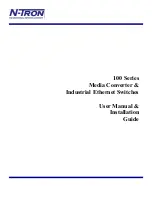
Magnum Quad-Series Fiber Switches
Installation and User Guide (06/03)
The RJ-45 ports run at 10/100Mbps with
N-way
auto-negotiation capability,
whereas the fiber port runs at 100Mbps with half- or full-duplex capability manually
selected. The default condition is full-duplex. Internal jumper settings allow technicians
to set the 100Mb fiber port to half-duplex mode. (See Section 3.4).
On Magnum Combo Quad-port modules, there are four LED’s for each RJ-45
port, which indicate status as described for the QPM-RJ45 in Section 2.2.4 above. The
fiber port is fixed at 100Mbps speed at all times, and has LEDs that indicate status the
same way as described for the Fiber Quad-port modules in Section 2.2.2 above.
2.2.6
Frame Buffering and Latency
The Magnum Quad-Series are store-and-forward switches. Each frame (or
packet) is loaded into the Switch’s memory and inspected before forwarding can occur.
This technique ensures that all forwarded frames are of a valid length and have the
correct CRC, i.e., are good packets. This eliminates the propagation of bad packets,
enabling all of the available bandwidth to be used for valid information.
While other switching technologies such as "cut-through" or "express" impose
minimal frame latency, they will also permit bad frames to propagate out to the Ethernet
segments connected. The "cut-through" technique permits collision fragment frames,
which are a result of late collisions, to be forwarded to add to the network traffic. Since
there is no way to filter frames with a bad CRC (the entire frame must be present in order
for CRC to be calculated), the result of indiscriminate cut-through forwarding is greater
traffic congestion, especially at peak activity. Since collisions and bad packets are more
likely when traffic is heavy, the result of store-and-forward operation is that more
bandwidth is available for good packets when the traffic load is greatest.
To minimize the possibility of dropping frames on congested ports, each
Magnum Quad-Series QS5116 Switches dynamically allocates buffer space from an 8
MB memory pool, ensuring that heavily used ports receive very large buffer space for
packet storage. (Many other switches have their packet buffer storage space divided
evenly across all ports, resulting in a small, fixed number of packets to be stored per port.
When the port buffer fills up, dropped packets result.) The other two Q-Series Switches
QS580 and QS5116 dynamically allocates buffer from an 4MB memory pool. This
dynamic buffer allocation provides the capability for the maximum resources of the
9
www GarrettCom com
.
.
















































